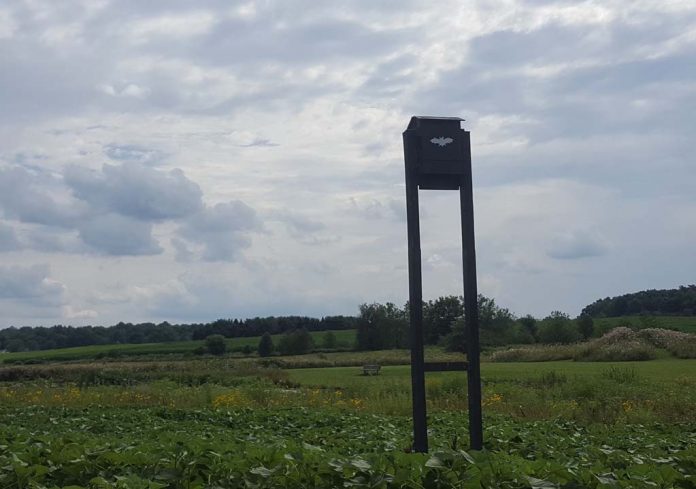Jamey Emmert and her husband put up a bat house two and a half years ago. It remained vacant till this spring, when a little brown bat they named Wyclef moved in.
“We were ecstatic to have this little guy living in the house,” Emmert said.
Bats hibernate in caves, rock crevices or buildings from November to March, but then they must find a place where they can roost during the day and hunt for insects at night. That’s when bat houses are helpful.
As a wildlife communications specialist for the Ohio Division of Wildlife, Emmert sometimes conducts programs on building small bat houses from kits. But the couple was given a huge bat house as a gift, one with multiple chambers that’s like an apartment building for bats. That turned out to be ideal for Wyclef, since males of the little brown bat species tend to be loners who don’t like roommates.
Specs
Each chamber of the house is about 20 inches high. The wood on the inside is scored or textured so the bats can dig in and hang on with the claws on their feet. With this bat-friendly decor, Wyclef can spend his days snoozing upside down
Emmert said bat houses should be put up as high as possible, at least 15 feet off the ground, because bats need some altitude before they can become airborne. For that reason, the bat house was put up next to the attic vent in the humans’ house.
There’s also a reason why the entrance to a bat house is at the bottom rather than on the front, like birdhouses. When Wyclef is ready to hunt bugs, usually a little after 9 p.m. on summer evenings, he “flings himself out of the opening at the bottom, drops down, makes a U-turn and comes up flying,” Emmert said.
Bat houses should face east or southeast so they don’t get too hot in the afternoon sun, she said. There should be no trees, vegetation or other obstacles in front of the house so that resident bats can swoop down and crawl up through the entrance.
Color is also important, Emmert said. Ohio has relatively mild temperatures for three-quarters of the year, so a neutral gray or greenish gray is good. In Canada, they want darker colors to absorb the heat, while reflective white is preferred in the South.
The Bat Conservation International website, batcon.org, has plans for building bat houses of various sizes. They also have a list of approved vendors who sell kits or already-assembled bat houses. The Bat Conservation & Management organization sells bat houses that range from one to four chambers, and “rocket box” houses that simulate a dead tree. Their website is batmanagement.com.
Gardening for bats
Another thing homeowners can do to help bats is plant native species that attract nectar-drinking insects, like moths. Emmert likes Culver’s root, evening primrose and spiderwort. She recommends getting a book called “Gardening for Moths: A Regional Guide” by Jim McCormac and Chelsea Gottfried.
Bats also need a source of water, but a bird bath simply won’t do, she said. Bats don’t land to drink, but zoom down and sip water while they fly. That means they need a pond, stream or other body of water that is long enough to accommodate their flight plan.
“Humans need bats, and for once, bats need humans,” Emmert said. “Do whatever you can to protect bat populations. Since everything is connected, you will be saving countless other species too.”













I have an area..I call The Forest..I would love to place a Bat House there.. any ideas..I know about the color height and maybe size..what about how to attach to a tree..